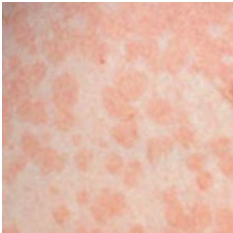Tinea Versicolor Causes, Symptoms, Diagnosis and Treatment

What Is Tinea Versicolor?
Tine vesicolor, is a common condition that causes small patches of skin to become scaly and discolored. The patches may be darker or lighter than your normal skin color, or may be red or pink. They tend to develop gradually and may join up to form larger patches over time. The area’s most often affected by tinea versicolor include the trunk (chest and tummy), neck, upper arms and back.
Although it may look unpleasant and the patches are sometimes itchy, tinea versicolor is harmless.
The yeast that causes tinea versicolor lives on everyone’s skin. It is not clear why the yeast overgrows on some people’s skin and not others.
We do know the following about tinea versicolor:
- People of all skin colors get it.
- Teens and young adults are most susceptible because they have oily skin.
- Older adults and children rarely get it unless they live in a tropical or subtropical area.
- People who live in non-tropical areas often see tinea versicolor disappear during the cool, dry months.
Causes of Tinea Versicolor
The fungus that causes tinea versicolor can be found on healthy skin. It only starts causing problems when the fungus overgrows. A number of factors may trigger this growth, including:
- Hot, humid weather
- Oily skin
- Hormonal changes
- Weakened immune system
Symptoms of Tinea Versicolor
Tinea versicolor symptoms include:
- Patches of skin discoloration, usually on the back, chest, neck and upper arms, which may appear lighter or darker than usual
- Mild itching
- Scaling
Tinea versicolor that develops in people with dark skin may result in the loss of skin color, known as hypopigmentation. For some people, the skin may darken instead of lighten. This condition is known as hyperpigmentation. Some individuals who develop tinea versicolor don’t have any significant changes in their skin color or appearance. In addition to changes in the color of your skin, you may also experience itchy skin.
Diagnosis of Tinea Versicolor
Your doctor can diagnose tinea vesicolor by looking at it. If a diagnosis can’t be made by looking at the skin then following test can be done:
- Skin scraping
- Potassium hydroxide (KOH) microscopy
- Biopsy, or tissue sample
Treatment of Tinea Versicolor
If your symptoms aren’t severe, you may choose to treat your condition at home. OTC antifungal creams or shampoos may be effective for
killing the infection. Examples of OTC medications that can be used to treat tinea vesicolor include:
- clotrimazole (Lotrimin AF, Mycelex)
- miconazole (Monistat, M-Zole)
- selenium sulfide (Selsun Blue shampoo)
- terbinafine (Lamisil)
Related Articles: 5 Amazing Supplement and Creams for Tinea Versicolor
If you seek medical attention for tinea versicolor, your doctor may prescribe different medications, such as topical creams that can be applied directly to the skin. Examples include:
- ciclopirox (Loprox, Penlac)
- ketoconazole (Extina, Nizoral)
Your doctor may also prescribe pills to treat tinea versicolor, including:
- fluconazole (Diflucan)
- itraconazole (Onmel, Sporanox)
- ketoconazole
Related Articles:
Swimmers Itch Causes, Symptoms, Diagnosis and Treatment
Tularemia Causes, Symptoms, Diagnosis and treatment
Cold Sores Causes, Symptoms, Diagnosis and Treatment
Hemangioma Causes, Symptoms, Diagnosis and Treatment
Progeria Causes, Symptoms, Diagnosis and Treatment
Raynaud’s Disease Causes, Symptoms, Diagnosis and Treatment
Stye Causes, Symptoms, Diagnosis and Treatment
Antiphospholipid Syndrome (APS) Causes, Symptoms, Diagnosis And Treatment
Castleman Disease Causes, Symptoms, Diagnosis And Treatment
Diaper Rash Causes, Symptoms, Diagnosis and Treatment
Cellulitis Causes, Symptoms, Diagnosis and Treatment
Prickly Heat Causes, Symptoms, Diagnosis and Treatment
By : Natural Health News




